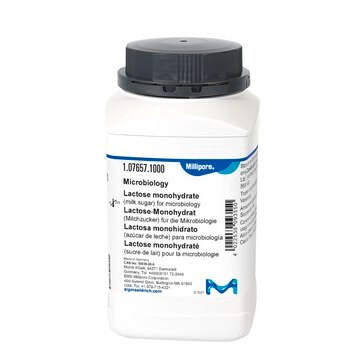L254
D-Lactose monohydrate
ACS reagent
Synonim(y):
β-D-Gal-(1→4)-D-Glc, 4-O-β-D-Galactopyranosyl-D-glucose, Milk sugar
About This Item
Polecane produkty
klasa czystości
ACS reagent
Poziom jakości
Postać
powder
aktywność optyczna
[α]22/D +52.4°, c = 4.5 in H2O
zanieczyszczenia
dextrose, passes test
sucrose, passes test
≤0.005% insolubles
4.0-6.0% water
pozostałość po prażeniu
≤0.03%
mp
219 °C (dec.)
ślady kationów
Fe: ≤5 ppm
heavy metals: ≤5 ppm (by ICP)
ciąg SMILES
O.OC[C@@H](O)[C@@H](O[C@@H]1O[C@H](CO)[C@H](O)[C@H](O)[C@H]1O)[C@H](O)[C@@H](O)C=O
InChI
1S/C12H22O11.H2O/c13-1-4(16)7(18)11(5(17)2-14)23-12-10(21)9(20)8(19)6(3-15)22-12;/h1,4-12,14-21H,2-3H2;1H2/t4-,5+,6+,7+,8-,9-,10+,11+,12-;/m0./s1
Klucz InChI
HBDJFVFTHLOSDW-XBLONOLSSA-N
Szukasz podobnych produktów? Odwiedź Przewodnik dotyczący porównywania produktów
Powiązane kategorie
Zastosowanie
- Synthesis of lactose-based surfactants: Research by Enayati, Gong, and Abbaspourrad demonstrated the use of d-Lactose monohydrate in the synthesis of lactose lauryl ester, employing aluminosilicate zeolite as a catalyst. This study presents a method for producing non-ionic surfactants, highlighting d-Lactose monohydrate′s role in industrial and pharmaceutical applications (Enayati et al., 2019).
Kod klasy składowania
11 - Combustible Solids
Klasa zagrożenia wodnego (WGK)
WGK 3
Temperatura zapłonu (°F)
Not applicable
Temperatura zapłonu (°C)
Not applicable
Środki ochrony indywidualnej
Eyeshields, Gloves, type N95 (US)
Choose from one of the most recent versions:
Masz już ten produkt?
Dokumenty związane z niedawno zakupionymi produktami zostały zamieszczone w Bibliotece dokumentów.
Klienci oglądali również te produkty
Nasz zespół naukowców ma doświadczenie we wszystkich obszarach badań, w tym w naukach przyrodniczych, materiałoznawstwie, syntezie chemicznej, chromatografii, analityce i wielu innych dziedzinach.
Skontaktuj się z zespołem ds. pomocy technicznej





